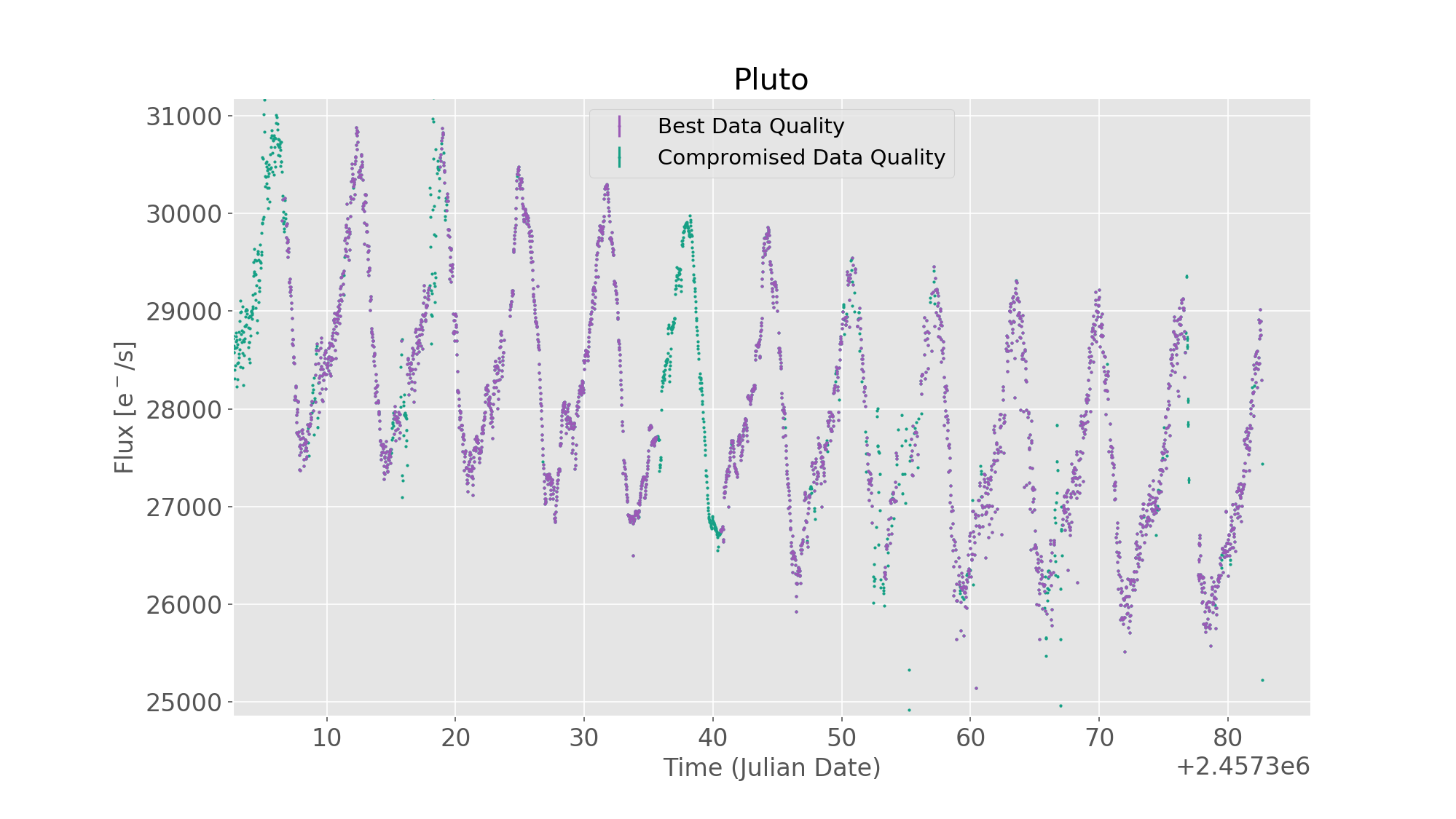Pluto
Pluto (a.k.a. 999) is a moving object from K2 campaign 7. You can read more information about this object at the JPL Small-Body Database Browser here. Data was taken from 04 October 2015 to 26 December 2015.
Pluto was proposed for by Benecchi in GO7012. If you use this data, please cite their proposal. You can find the bibtex citation by clicking the button below.
@ARTICLE{asteriks,
author = {{Hedges}, C. and Co},
title = "{}",
journal = {},
archivePrefix = "arXiv",
eprint = {},
primaryClass = "",
keywords = {},
year = ,
month = ,
volume = ,
pages = {},
doi = {},
adsurl = {},
}@MISC{2014ktwo.propGO7012,
author = {{Benecchi}, B. and {Schwamb}, S. and {Binzel}, B. and {Lisse}, L.},
title = {The Lightcurve of Pluto Post New Horizons},
abstract = {Discovered in 1930, Pluto is a unique dwarf planet that has chal
lenged and inspired the minds of many. It is a key object in the
third zone out from our Sun and provides important insight to f
ormation and collisional processes that were at work in the orig
inal solar nebula. In July 2015 the New Horizons spacecraft (a N
ASA mission) will encounter this small, dark, icy world and the
family of objects that orbit it providing a once-in-a-lifetime o
pportunity to directly link our Earth-based view of Pluto with g
round truth provided by in situ measurements. However, this enco
unter will be short-lived compared to other planetary voyages be
cause it is unfeasible to slow the spacecraft down to orbit with
in the Pluto system; instead this visit will be a flyby. Studies
from Earth-based or Earth-orbit facilities prior to and post en
counter will provide critical baseline and context information f
or optimal interpretation of the valuable flyby science data. Pl
uto is known to be a constantly changing world due to the solar
energy being received decreasing by ~2% per year on account of i
ts eccentric orbit now carrying it rapidly away from perihelion.
Whats more, the orientation of Pluto's spin axis and the sub-s
olar latitude (the height of the "midday Sun") changes by more t
han 1 degree per Earth year, bringing 100,000 square kilometers
of new surface area into sunlight for the first time in a centur
y (while casting an equal and opposite polar area into a century
long arctic winter). These orbit-related effects on the atmosph
ere and surface of Pluto are on top of the well-known longitudin
al variations measurable over the course Plutos 6.387 day rotati
on. Observations of Pluto one year prior-to and post-flyby will
allow us to identify evolving trends in the system which could b
e missed if we focused on only the flyby dataset. Our ultimate g
oal is to better understand Pluto, its family of satellites and
their evolution since formation. We propose to observe the Pluto
system, which is on silicon in the selected Campaign 7 K2 field
. These observations will take place after New Horizons has comp
leted its flyby and will provide a key baseline of photometric o
bservations that are not available from ground-based observatori
es because of Pluto's position relative to Sun during the timefr
ame of this campaign (Oct-Dec 2015). Pluto is relatively bright
, MV~14, but not overly bright, so it is an ideal object for the
K2 set-up. The positional uncertainty of Pluto over the observi
ng period is less than a Kepler pixel providing starlike PRFs in
a single K2 observation. Therefore, monitoring Pluto, which mov
es only a few arcminutes per night, requires a target pixel mask
over its path on the FOV. Pluto's rotation period is 6.387 days
so the collected 30-min integration "long cadence" datapoints w
ill provide measurements of nearly 12 full rotations of Pluto an
d its companions. Likewise, the 3-month baseline also allows us
to sample seasonal variations and solar phase angles ranging fro
m 1.7°-0.2° during Campaign 7. The continuous 30-minute sampling
interval provides a time resolution not possible from any other
observatory. Some complications for interpreting the dataset wi
ll result from the large pixel scale, but the high sampling dens
ity will allow for disentanglement of the individual Pluto-Charo
n lightcurves. This will be the highest resolution Earth-center
ed dataset of the Pluto system ever collected and will provide c
ritical long time baseline photometry for tying the New Horizons
sub-disk photometry to disk integrated observations. This datas
et is critical for our continued study of Pluto's evolving surfa
ce-atmosphere interaction as it recedes from the Sun and of the
influence of Pluto and Charon on each other. It will also provid
e insight for interpretation of other dwarf planets and Kuiper B
elt objects in the third zone of our Solar System.}
howpublished = {K2 Proposal},
year = {2014},
month = {October},
url = {https://keplerscience.arc.nasa.gov/data/k2-programs/GO7012.txt},
notes = {K2 Proposal GO7012}
}
Acknowledgement:
This work uses...Download Light Curve
If only want the light curve of the object with the optimal aperture, download this product. This will give you one .fits file with several extensions. The first extension is the optimal apertures determined for this target. Further extensions contain a range of aperture sizes. You can read more in our readme.
Download Target Pixel File
Our code asteriks creates Moving Target Pixel Files, which are similar to Kepler/K2 TPFs, and contain stacks of images from the telescope. Moving TPFs track the motion of solar system objects, so that they are always centered in every image. Moving TPFs are background subtracted. The movie above shows a Moving TPF with background subtraction on the right.
Run our code
You can run our code asteriks to regenerate any of these light curves yourself, or generate light curves of other objects. You can read more about our code at our GitHub Page and you can read more about how the code works in our recent paper
